For three glorious days this past January, the 2017 Winter Fancy Food Show—the self-described “largest specialty food and beverage show on the West Coast!”—inhabited the Moscone Center, the colossal convention center in downtown San Francisco. Booth after booth of brands both big and small, booths with staggering square footage and others the size of shoeboxes, were manned by food entrepreneurs hoping to catch the eye of distributors or big-name retailers who might carry their product to fame and fortune. If you’ve been to Costco for the samples, you have glimpsed the glory of the Fancy Food Show. I say glimpsed because here, you don’t have to be coy about your lust for samples. Samples are what we’re all here for.
A person in a Katy Perry Left Shark costume sells something called “white shark chai.” One sign boasts “First organic kosher gummy bear”; another, “World’s best gummy bears.” Chips and crackers of every stripe are well represented, as is jerky made from the dried flesh of both middle-of-the-road (beef, pork) and alternative animals (elk, bison, boar). There are booths devoted to packaging and a booth for personalized spring water: Get water labeled with your name on it, as Peeps, the marshmallow birds, have. The cumulative effect on me is it inspires both skepticism and awe.
My method/philosophy here is to let my heart want what it wants. I eat every pickled vegetable there is. I indulge my inner (and also outer) halloumi fiend. Whenever I see a cured pig leg being ceremoniously sliced, I pause to eat some fallen meat shavings. I avoid all energy drinks because my heart is racing already, hopped up on passionfruit yogurt and fingerlime caviar. How could it not, at the Winter Fancy Food Show?
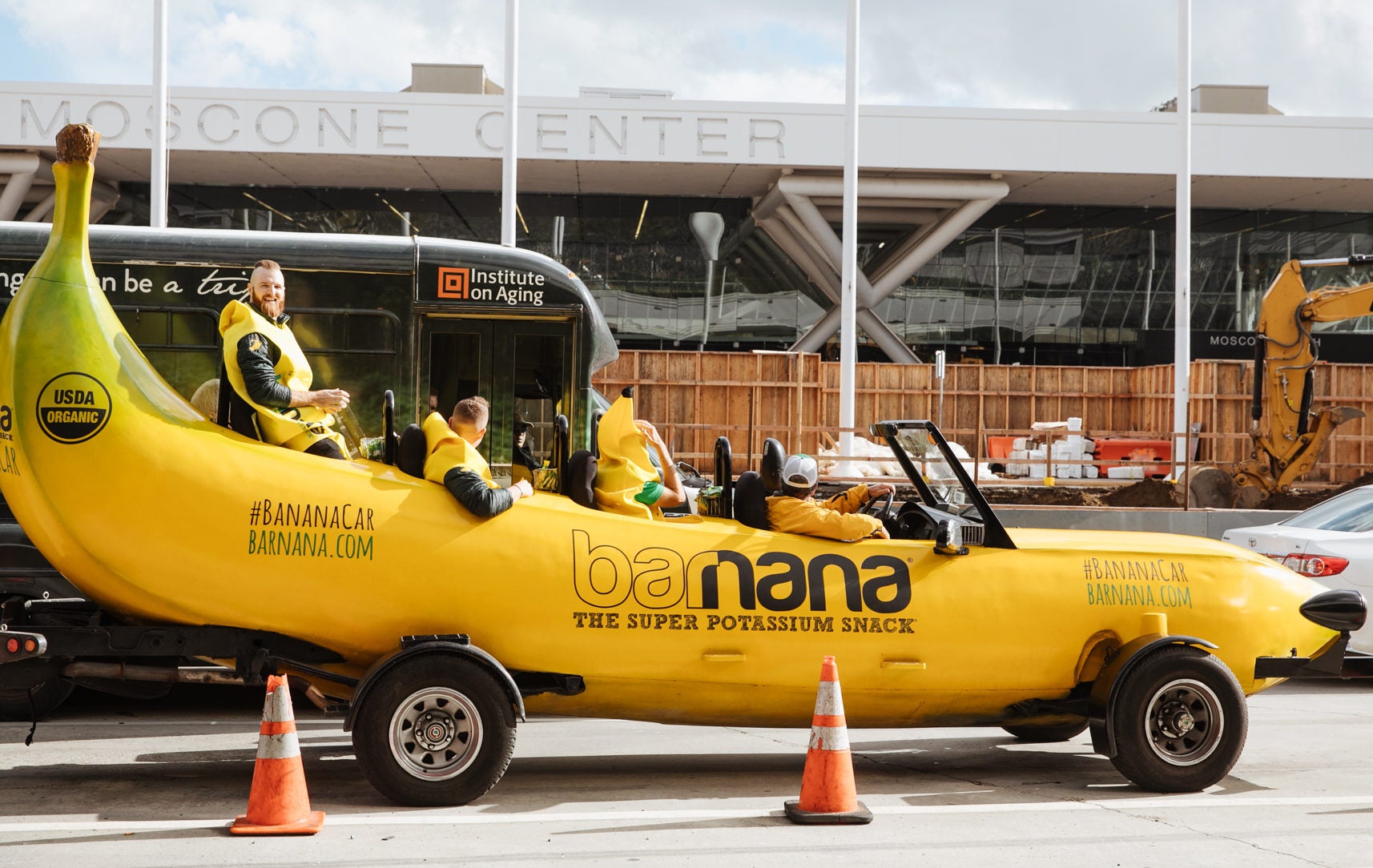
On the way to the Moscone Center I’d noticed a car shaped like a banana. So when I stumble across a booth that looks like it says “BANANA” but actually reads “BARNANA”—the R is melded to the N—I am titillated. They appear to be snacks: Some are cubed, some are more Raisinet shaped. “I saw a banana car outside,” I say to the young woman manning the samples. “Is that yours?” And she laughs: Yes, it is! “It’s the newest member of our team,” she says. It turns out the banana car was driven up from Los Angeles and Barnana is a four-year-old, Santa Monica–based company that makes snacks with dehydrated (“upcycled”) bananas. “We take the bananas from South and Central America that would otherwise be thrown away, the imperfect ones, and we use them for our product,” says Rachel Chambers, a territory sales manager for Southern California. I try a toffee-flavored nugget: sweet and deeply banana-y, not overly virtuous-tasting. I like it.
My attempt at balancing out the cured meat I’ve been pounding is to drown myself in turmeric drink samples, also well represented here. At one booth, the turmeric tea is a compressed coal-like object, like a miniature Lush bath bomb. The booth says TEA DROPS. It’s organic tea that dissolves in your cup, so you don’t need a tea bag: ground whole-leaf tea, spices, and a little bit of sugar are pressure-cooked into a shape.
My method/philosophy here is to let my heart want what it wants. I eat every pickled vegetable there is
There’s a star-shaped nugget and a heart-shaped nugget, in flavors like “vanilla white tea” and “rose Earl gray.” “So the idea is no waste?” I ask the founder and CEO, Sashee Chandran. Here at the Fancy Food Show, we are surrounded by shallow shots of sparkling water, and single tubes of pasta or lone potato chips in their own plastic cups. “The idea is premium tea on the go that’s convenient and fun,” she responds. Chandran had been working at eBay when she “noticed how difficult it was to make tea at work,” she says. A Tea Drop goes into a cup and the water dispensed on top. You mix to dissolve and drink your tea. My turmeric sample is a little chalky at the end, but serviceable.
You know what they say about guys with enormous booths. So I’m mostly avoiding them—I’m rooting for the little guys, anyway. But a biggish booth that says DANG catches my eye: It’s a Berkeley-based brand founded by brothers and named after their mom, Dang. About four years ago they debuted with roasted coconut shavings, Dang’s recipe; the coconut shavings are a component of miang kum, Thai lettuce wraps. Here at the Fancy Food Fair, they also have on offer an onion chip, which turns out to be amazing.
They’re sweet, salty, ideally balanced—not onion-flavored chips, but actual slices of onion. I could eat approximately 500. Vincent Kitirattragarn, the founder and a former engineer, tells me the onion chips are “vacuum fried,” a technique popular in Asia: “You fry things at lower temperature and lower pressure, and you can spin out most of the oil. That’s an engineering thing.” And their newest product is a line of sticky-rice chips: organic sticky rice that’s been steamed, bound together with watermelon juice(!), and crisped. They’re astonishingly crunchy and savory-sweet—a far cry from the standard rice cake.
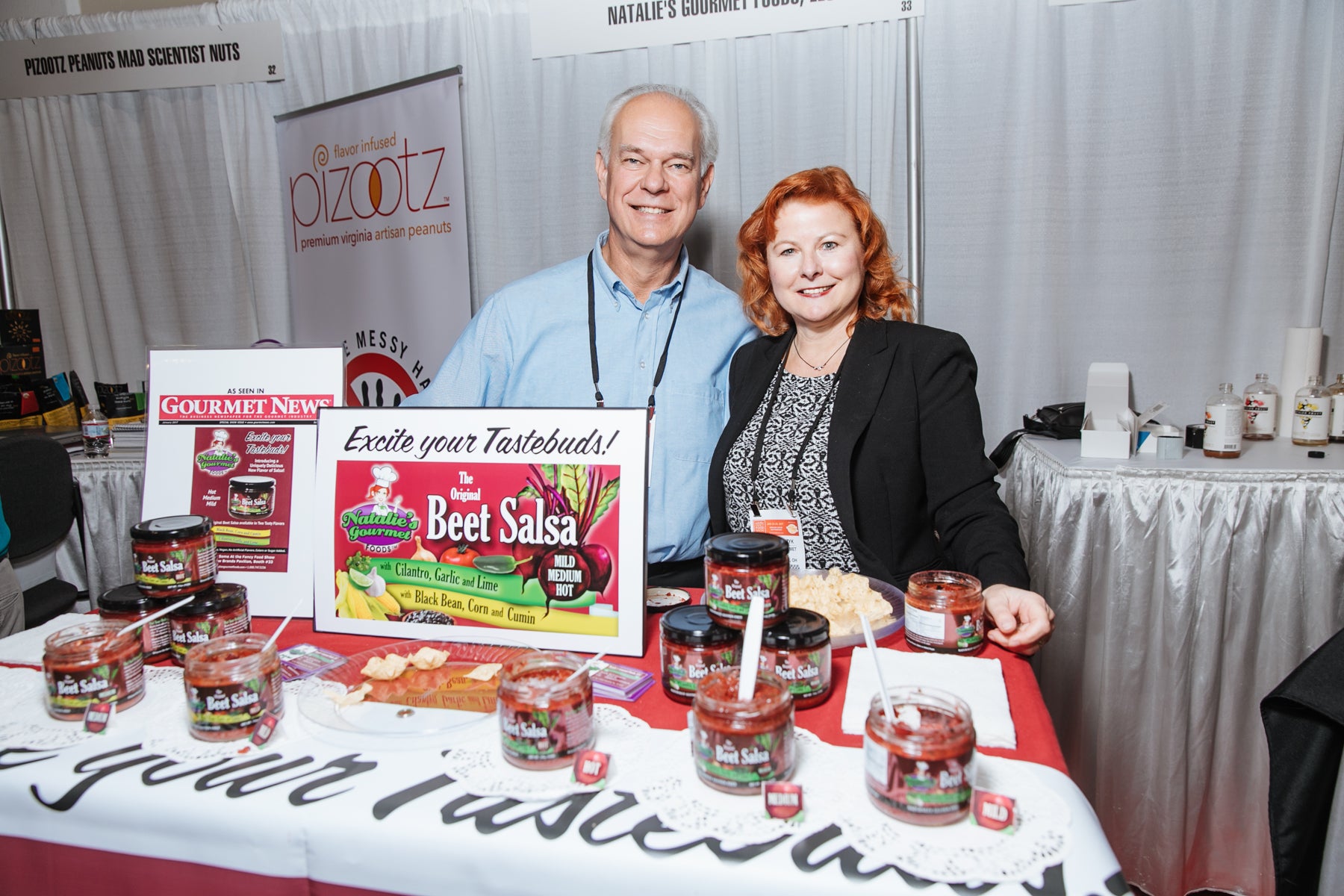
A little annex that looks like it was a last-minute addition turns out to be the New Brands Pavilion, for first-time Fancy Food attendees. There, I wander past a vegan, dairy-free, paleo, banana-based “ice cream” called Snow Monkey, and spot Myron Kuzyk manning a booth for a brand called Natalie’s Gourmet Foods, from Cleveland, Ohio. Laid before him are Tostitos Scoops! tortilla chips and jars of purplish red salsa placed atop doilies. I scoop a Scoop-ful: It’s BEET SALSA, sweet and beet-y, but not too beet-y.
I’m into it. A big white guy at the booth talking to Myron says, “Beets are so hot right now,” then wanders off. I ask Myron, Why beet salsa? “I’ll tell you what happened,” he says, launching into his spiel. “My wife started adding beets to her homemade salsa, just to get that crimson-red color. We started noticing the sweetness of the salsa.” The salsa is sweet without sugar added. “A very good, heart-healthy snack,” Myron explains. “No preservatives in it. Ten calories per serving, 11 servings per jar.” I shovel more salsas into my gaping maw, via Scoops. “Is your wife the Natalie of Natalie’s Gourmet Foods?” I ask. “Yes!” he replies, happily. She’s just stepped away. “We’re in about 250 stores in the Midwest, but nothing West, nothing South, nothing East,” he explains. “This is our first food show, and we’re having a great time.”
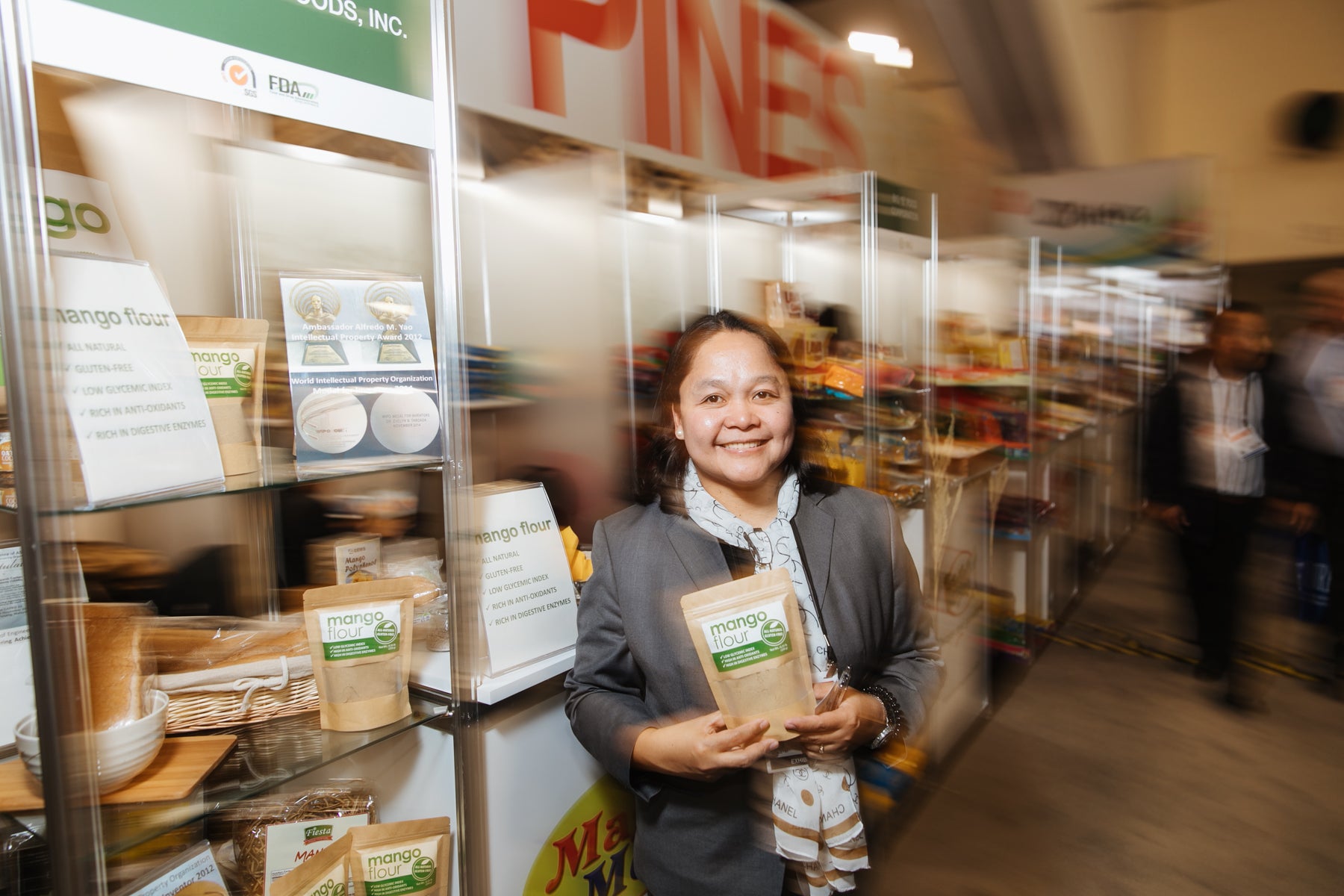
In the international section, there are tequila samples in Mexico and canned meats and hot-pink hot dogs (the brand is “Tender Juicy”) in the very modest Philippines. Also in the Philippines, I notice some ladies behind a booth that says MANGO FLOUR. Intrigued, I approach. I learn that there are many dried-mango producers based in Cebu, in the Philippines. I nod, understandingly; I know this firsthand because my freshman-year-of-college dried mango consumption was considerable. Mango flour came about because they were trying to find a use for the wasted seeds and skins—as a result, it’s gluten free.
“We have the lead scientist over here,” Carolyne Go, the CEO of Magicmelt, tells me. “After three years of study, the team of three engineers headed by Evelyn came up with the results.” What’s it like to make flour from mangoes, I ask Evelyn. “Tedious,” Dr. Evelyn Taboada laughs. Apparently it’s hard to land at a not-gross flour that’s also nutritious, and mango flour, they boast, is naturally rich in vitamins, minerals, fiber, and polyphenols. I try a square of mango-flour cake—some kind of spice cake. It’s a good, undistinctive cake. I try a pinch of the flour itself: it tastes like nothing, not perceptibly mango-y in the slightest.
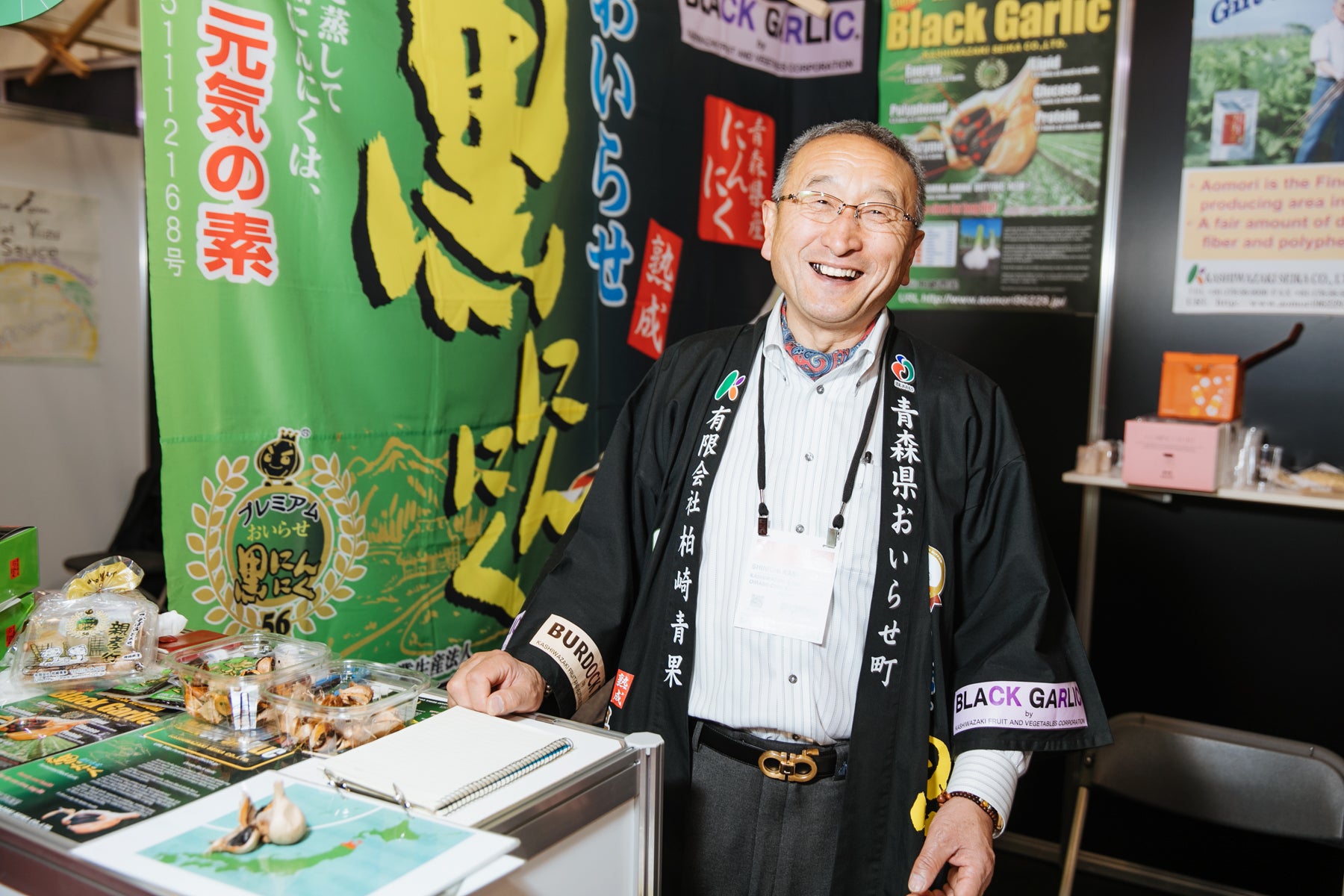
I linger in Japan, where there’s a farm selling citrus juice. “What’s special about this juice?” I ask. “It’s squeezed gently,” the woman responds, matter-of-factly. A booth next to theirs is for BLACK GARLIC: a gray-paper bulb of garlic containing pitch-black cloves. “Anti-aging by Gift from the Earth,” boasts a poster. The guru-esque older man in the poster, holding up a garlic plant, appears to be at the booth. I start to ask him questions when he shakes his head; he doesn’t speak English. His associate, a woman named Hiromi Yamamoto with a pert pixie cut (who declines to be photographed), attends to me.
Garlic with particularly large, uniform cloves (six cloves or fewer per bulb) is grown in the Aomori prefecture, then “slow-aged” for 40 days: “Let the garlic slow, slow, slow change, change the color, change the taste, change the benefits,” Yamamoto says. I ask if people cook with black garlic in Japan. She tells me it’s more like a vitamin; their slogan is “one day, one clove, long life.” An aisle over, there’s another black garlic booth, Momiki Black Garlic, with garlic grown in Miyazaka, marketed more as an ingredient than a health supplement. “You can spoon it on top of pizza, Bloody Mary, steak, seafood.” On display are black garlic salad dressings and spaghetti sauce. I dip a chip into the yuzu pepper tomato sauce; it’s sweet and mushroom-y.
Near Spain I find a football player–sized gentleman manning a booth with bottles of Canadian MAPLE SYRUP and clear bottles of carbonated MAPLE WATER—a byproduct of producing maple syrup from rare Nordic Sugar Maple trees. The company is Highland Maple, based in Saint Quentin, New Brunswick, and Summerland, British Columbia. The founder, Roch Fortin, pours me a little plastic spoon of syrup (it’s single-blend syrup, and “the farmer is unique, just like a winemaker,” he says) and a little shot of fizzy maple water—the label says ARBEAU, and it’s the world’s first certified organic maple water.
“I’m retired, can you believe that!” he says. “What are you retired from?” I ask. “Can you guess?” he responds in his pleasant French-Canadian accent. “Fireman?” I venture, and I am not far off: He was a police chief for 32 years, and when he retired, he promised the families in his economically depressed community that he would find a way to give back. Hence: the marketing of maple syrup and water. This is more a “social enterprise” for him: His employees are largely people with long-term disabilities or low incomes.
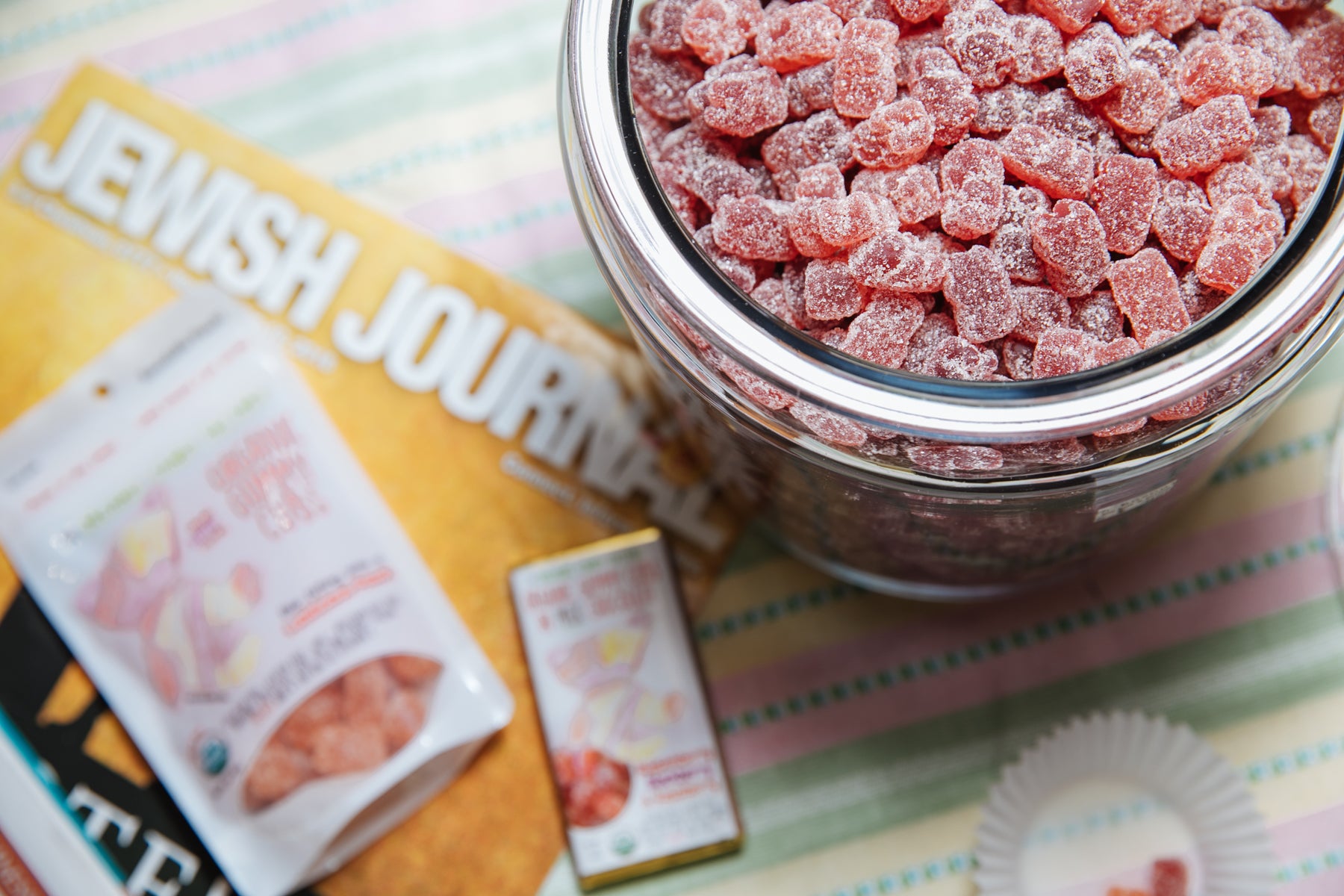
Curious to try the first organic kosher gummy bear, I seek out the ORGANIC CANDY COMPANY, where the amiable Piper Cochran is doling out fruit pectin–based gummy “cubs” from big jars. The bears are very fruit forward (they come in peach, blackberry, raspberry, and boysenberry, with a sugar coating), and delicious: They’re more like gum drops or pâte de fruit in texture—yielding under the teeth—than the conventional chewy gummy. The bears were certified kosher at the Coffee Bean & Tea Leaf’s request: For that certification, a rabbi inspected the entire bear supply chain. Cochran says the company was founded by her daughter, Ginger, when she was five—back then they bagged bulk candy and sold it online.
Ginger is 12 now. “She’s the brains behind it all. She told me to put gummy bears in chocolate. I said, ‘Honey, nobody’s going to like that. It’s a little weird.’ I was wrong.” The chocolate in question comes in a small, thin bar, with little bear bodies eerily blanketed in Pompeiian chocolate lava. The fruity-bear-and-chocolate combo is surprisingly good. “She’s a funny little entrepreneur,” Cochran laughs. “Unfortunately they won’t let her come, because she’s 12. You have to be 18.”